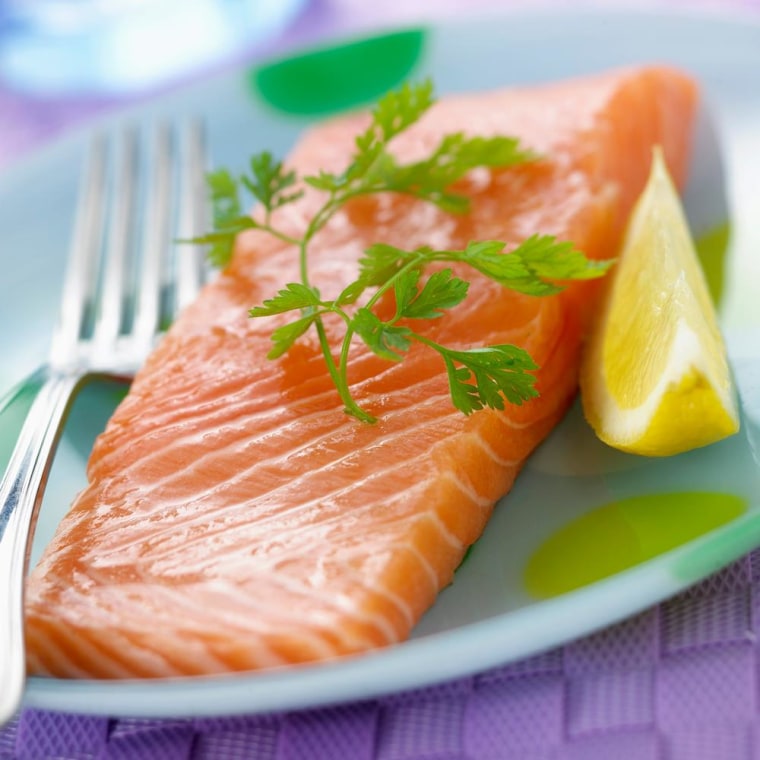When hair looks limp, dull and lifeless, people often turn to new shampoos and conditioners for that extra oomph. But really, a poor diet could be the culprit for lackluster locks.
“[Lifeless hair] is usually coming from the inside out,” says Michael Stranko, a hair stylist at Hair Designs by Karen Greb in Pittsburgh.
Stranko notices that when a client’s hair changes, many times diet is to blame. One woman was on a doctor-ordered, low-fat diet and even two month after it ended, the stylist saw a difference.

“Her hair turned very thin, very brittle, and there was no life to it. When you aren't getting a proper nutrition it … comes out through the hair,” Stranko says.
RELATED: 9 secrets to smooth, healthy hair from Reese Witherspoon's hairstylist
Though there is a limited amount of science to back up Stranko's observation, eating protein and certain fats is said to help give you lustrous hair.
“If you don’t have enough protein, you can end up having hair that is dry and thinner. Protein is the building block for ... keratin,” says Dr. Debra Wattenberg, a New York City dermatologist at NY Skin Rx.
Meat, fish, beans, and soy will arm the body to make keratin, a fibrous protein that builds hair and nails. While omega-3 fats, found in fish, walnuts and flaxseed, help make hair shine.
“Essential fatty acids are really important,” says Dr. Apple Bodemer, an assistant professor of dermatology at the University of Wisconsin School of Medicine and Public Health. “People who are on really, really low fat diets [have] hair breaking and hair falling out.”
Also important to healthy hair: vitamin D, zinc, and iron. Iron helps red blood cells carry oxygen and nutrients to the hair follicle and zinc works as a co-enzyme, helping to create the hair structure. Less is known about the role of vitamin D, but experts suspect it helps with the growth cycle.
RELATED: A clever way to repair split ends and 8 more hair tricks
While some people pop biotin supplements for hair health, there's no clear evidence that extra vitamin B — the type of vitamin biotin is — is a magic bullet for lush locks. Vitamin B serves as a co-enzyme to help hair develop. People with B deficiencies, which are serious and rare in the United States, often do lose hair, but it’s hard to say if extra biotin helps; some people swear by it, while others notice no difference.
Eating the daily recommended levels of fish, meat, and dairy should give you enough vitamin B for healthy hair.
Stress or poor diet can cause breaking and thinning hair, but when people notice a change in their hair, they might want to visit a doctor. Breaking and thinning hair may indicate anemia, vitamin D or B deficiencies, low zinc levels, or symptoms of a more serious disorder such as thyroid conditions or GI disorders, such as Crohn’s or celiac disease, when patients can’t absorb nutrients properly.
While some foods make hair strong and beautiful, eating too much of others can make hair brittle and thin.
Here's what to watch out for:
Vitamin A
While vitamin A bolsters the immune system and aids vision, overloading with vitamin A causes hair loss.
“Too much vitamin A can cause you to lose the hair and vitamin A can be toxic to the hair follicles,” says Wattenberg.
The two types of vitamin A are found naturally as either retinoid in animal products or beta carotene in vegetables, such as carrots.
RELATED: Make your own all-natural shampoo (for under a buck!) and more DIYs
“It would take like a million carrots” to damage a person’s hair, says Dr. Whitney Bowe, a dermatologist at Advanced Dermatology in New York City.
But people constantly popping vitamins might be ingesting too much vitamin A, causing thinning hair.
“[Vitamin A] will act on the oil gland and shrink it down,” says Bodemer. “The oil gland is not producing the same amount of oil [to] help coat [the hair] and make it healthy, strong and shiny.”

Yes, fatty fish like salmon and tuna contain omega-3 fatty acids, which give hair its luster.
But tuna and swordfish also contain mercury, so excessive consumption of the wrong kind could wreck your hair.
Experts believe mercury disrupts protein development and interferes with zinc, wrecking the growth process.
RELATED: How often should you clean your hair brush — and the right way to do it
Wattenberg says people think if the fish is cooked, they’re protected from mercury, but that’s not true.
There's also no clear guidance on when mercury levels in the body become toxic. But as long as you're not pregnant, it's probably safe to eat light canned tuna two to three times a week, or about 12 ounces total, according to the Food and Drug Administration and the Environmental Protection Agency.
Sugar and juice cleanses
While there’s not a lot of research connecting high-sugar diets with hair loss, experts know that sugar promotes inflammation. When people eat sugar or carbs, the sugar floods the blood, causing a spike of insulin and androgens, which bind to hair follicles and cause the hair to fall out.
But bingeing on leftover Valentine’s Day truffles won’t lead to hair loss. It’s normally seen in people who chronically have high levels of insulin.
“When inflammation is constantly driven by high glycemic and high sugar diets, [it] messes with the immune system and that is where the high sugar diets are coming more into play [with hair health],” says Bodemer.
Bowe says she sometimes sees short-term bad effects of too much sugar when her patients try crash diets or cleanses.
RELATED: 10 things we've all been getting wrong about hair
“Juice cleansing ... is the classic example of not getting enough protein. They are literally just getting sugar,” says Bowe. “You can tell a difference in the hair.”
This article was originally published on Feb. 27, 2015 on TODAY.com.